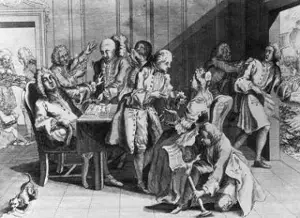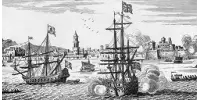The War of Jenkins' Ear
Robert Jenkins was the namesake of the war, an 18th-Century struggle between England and Spain over shipping rights in the Caribbean. In 1713, the two nations had as part of a treaty to stop a war, signed a trade agreement that gave British merchants passage to and from Spanish colonies in the New World, shipping material goods as well as enslaved people. The treaty put a cap on the amount of shipping allowed in a year. During a brief war in the late 1720s between the two nations, Britain approved a Spanish request to stop and search British ships suspected of smuggling. That war ended in 1729, but the Spanish had used to boarding British ships and the British had gotten used to bending the rules. On April 9, 1731, a British sea captain named Robert Jenkins was aboard his ship Rebecca near Havana, carrying a cargo of sugar from Jamaica to London, when the ship was boarded by the Spanish Coast Guard. A fracas ensued, during which one of the Spanish sailors cut off one of Jenkins's ears. The Spanish eventually left the ship, and Jenkins kept his ear. When the ship returned to England, Jenkins reported the incident and a brief public outcry ensued. The episode was forgotten for a time. 
Hostilities increased between England and Spain as the 1730s progressed. Leaders of the two countries came to another agreement, the Convention of Pardo, under the terms of which Spain agreed to pay England damages done to English vessels. Spain did not, however, agree to stop interfering with English shipping. The mood in England's Parliament was hot and heavy for war. During one testy debate in 1738, someone mentioned the case of Captain Jenkins and his lost ear. Some accounts even have Jenkins bringing his ear–which he still had, preserved in a jar–into Parliament and showing it around. That debate and others like it convinced England that it was time for war. 
The two countries went to war on Oct. 19, 1739. England had initial success, with a large force under Vice Admiral Edward Vernon sacking the Spanish settlement of Porto Bello and the destruction of the fortress of San Lorenzo el Real Chagres, both in what is now Panama. Spain resisted further English attacks, in Cuba and at Cartagena, in what is now Colombia, at which British forces attacked three separate times and had nothing to show for it but casualties. England also sent a squadron of ships under Commodore George Anson to attack Spanish possessions in the Pacific. After a series of misadventures, they carried on across the world's largest ocean and, in fact, circumnavigated the globe, returning home more than three years later. The conflict spread to North America, with Georgia colony leader James Oglethorpe leading expeditions into Spanish Florida, seizing two forts and attempting to seize a third. He and his regiment fought off a counterattack on St. Simons Island in 1742. In that same year, the focus of both countries shifted to a much larger conflict, the War of the Austrian Succession, which involved most of the major powers of Europe. The Treaty of Aix-la-Chapelle, ended that wider war in 1748, and the Treaty of Madrid two years later officially ended the War of Jenkins' Ear. Jenkins did not fight in either conflict. He was dispatched to the island colony of Saint Helena an acted as acting governor for a time in the early 1740s, after which his story is lost. As for the name of the war, it came much later, in the mid-19th Century, courtesy of the British historian Thomas Carlyle. |
|
Social Studies for Kids
copyright 2002–2025
David White




